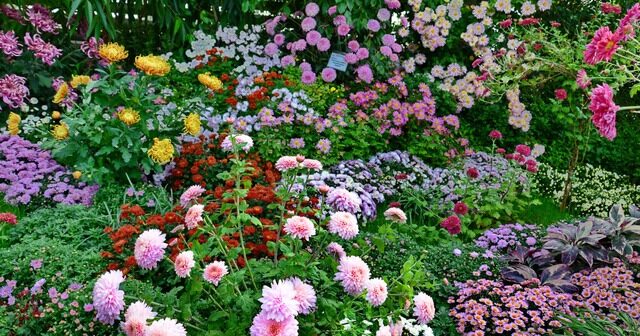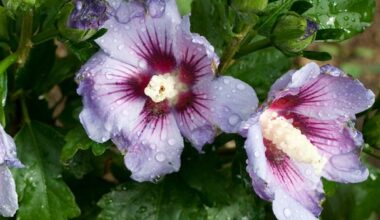The Chrysanthemum (Chrysanthemum), also known as the daisy of the dead, is often associated with All Saints’ Day and the flowering of tombs. However, it is beginning to regain its popularity: more and more towns are blossoming their flower beds and balconies with varieties of multicolored chrysanthemums reminiscent of the full range of autumn tones!
Chrysanthemums are planted in fertile soil, deeply loosened and above all well drained to increase their hardiness, because more than the cold, they fear winter humidity. They give the best of themselves grown in the sun.
Contents
When to plant chrysanthemums in the soil?
Plant them in early fall or spring. In cold regions and in heavy soil, avoid planting in the ground after the beginning of November if you wish to keep your chrysanthemum. Wait until the end of winter.
Where to plant the chrysanthemum?
Chrysanthemum prefers a sunny location, but the young plants must be protected from the scorching sun. It does not like acidic or humid soils. They like well drained and calcareous soils.
Chrysanthemum goes well with aster, dahlia, shrubs such as caryopteris, perovskia, lavatera and small conifers.
It can be used to decorate a bed, a flowerbed, a border, but also in a pot, a planter box and a bouquet.
Planting Chrysanthemums
Chrysanthemums are best planted in the spring because, although they will not flower until late summer or autumn, they will be well rooted and will withstand the rigours of autumn and winter much better.
- Place seedlings in the spring in a well-drained and amended soil.
- Chrysanthemums that are bought in pots in the fall can be planted directly in the ground, in a pot or in a planter box, ideally with soil but their rusticity will be less.
- You will choose a sunny spot to encourage flowering.
Perennial Chrysanthemums
- Perennial bedding chrysanthemums are sown in warm weather in February-March; daisies in autumn from October to March.
- Plant perennials in spring, in pots or in the ground.
- For pot planting, choose a potting soil for flowering plants.
- A sunny location favours flowering and stimulates the growth of stems.
- Water moderately.
Annual Chrysanthemums
- They are sown in cold frames or in nurseries from February, or in place after frost. In clement regions, they can be sown in autumn to advance the flowering.
- Transplant the plants in full ground in May, after the frosts by respecting a spacing of approximately 15 inches.
- Water moderately.
How to plant chrysanthemums in the ground?
- Prepare the soil carefully and amend it generously with organic manures such as ripe compost. Lighten it with coarse sand or gravel if it tends to retain water in the winter.
- Make sure the root ball is not dry before planting. Water thoroughly.
- Mulch the soil around the plant to limit water input or the effect of frost if planting in the fall.
Chrysanthemum care
Watering
Water regularly to keep the soil cool throughout the growing season (starting in April). Mulch or supplement the mulch installed at planting. Don’t overwater either to obtain stocky plants with lignified stems.
Fertilization
Complete the decomposition of the mulch, which provides organic matter, with a few sprinkles of liquid fertilizer for flowering plants or natural nutritive liquid manure from June to September.
Winter protection
Before the first big frost, mulch the hardy strains of chrysanthemums the first winter and the less hardy strains every winter. Install a light, airy mulch to prevent moisture from persisting. A cover of dry ferns is ideal.
If a strong frost is forecast, wrap the pot (pot and antler) with a winter fleece or store it in a dry, frost-free room in the house (not necessarily lit since the chrysanthemum is obsolete).
Chrysanthemum Pruning
In tall varieties, a pruning of half of the branches at the end of spring (as is done for their aster cousins) makes it possible to obtain well branched and compact chrysanthemums that hold well during flowering.
Avoid this operation in cold regions as it delays flowering. After flowering, remove the deflowered branches before installing the protective mulch for the winter.
Chrysanthemum attacks and diseases
A dry and confined atmosphere favors the attacks of red spiders. Increase the hygrometry by watering more regularly and showering the foliage.
On the other hand, an atmosphere that is too humid can cause the appearance of oidium, which can be detected in mealy deposits on leaves and stems. Rust (rust pustules on the back of the leaves) reflects a nutrient imbalance, lack of fertilizer or too much nitrogen. Beware of slugs and snails fond of young spring shoots!
Summary
Flower of autumn, the chrysanthemum is mainly used to flower the cemeteries at All Saints’ Day. In countries where it is native like Japan, it has a positive symbolic value and represents joy and happiness. It has even become the symbol of China.
The Chrysanthemum requires sunny exposure, and is suitable for almost all soils, although it prefers light, fertile, neutral to slightly acidic soil, not too dry to cool; just avoid very acidic or very calcareous soils. It settles imperatively in well-drained soil, as it does not live long in heavy and humid soils in winter.









